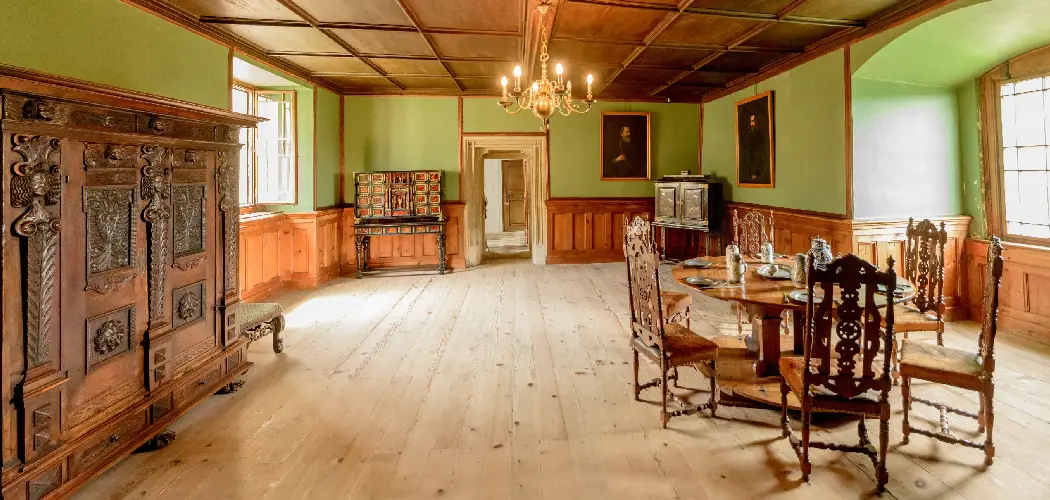A beautiful wood floor can add a lot of character and charm to your dining room, but there’s nothing worse than seeing all those scuff marks and scratches from chair legs. However, you don’t have to resort to replacing your lovely wooden floors just yet – with a bit of effort and the right protection tools, you can keep them looking good as new for years.
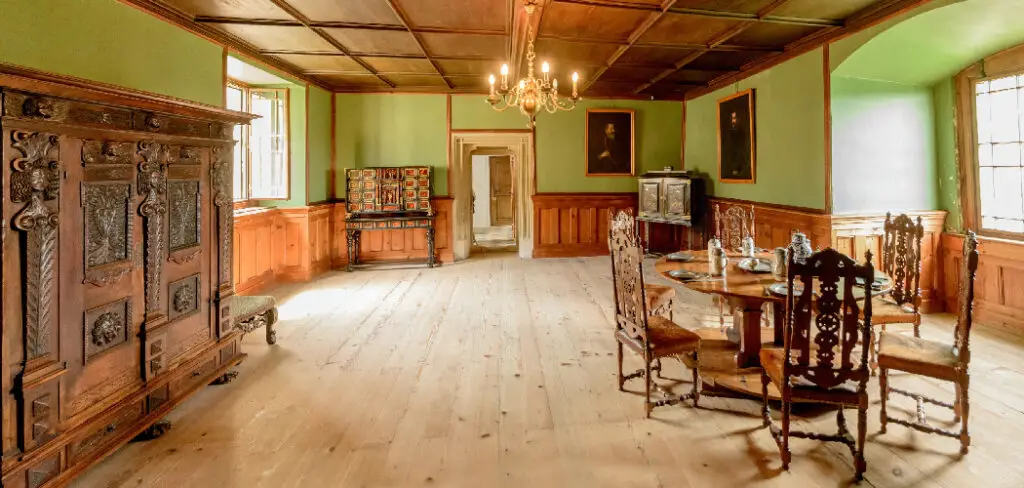
In this blog post, we’re going to look at some simple ways how to protect wood floors from dining room chairs so that they stay looking their best. From felt pads and glides for furniture legs to smart cleaning practices – these tips will help ensure that your precious wooden surfaces remain in pristine condition!
Importance of Protecting Wood Floors from Dining Room Chairs
Protecting your wood floors from dining room chairs is a must if you want to keep them looking their best and lasting for many years. Not only will it prevent permanent damage, but it will also help reduce wear and tear on the furniture. Unprotected furniture can gouge the flooring, leave scratches or dents, and cause discoloration. In extreme cases, unprotected furniture may even lead to splintering of the wood floorboards.
Using protective materials such as felt pads can help protect your wood floors from the everyday use of dining room chairs. Felt pads are soft pieces of material that are placed between the chair’s legs and the flooring surface. The felt helps absorb shock and don’t allow metal, wood or plastic chair legs to come in contact with the flooring.
Adhesive felt pads are also available and can be used for a more permanent solution. They stick directly to the bottom of the chair leg and don’t move around during use like other non-adhesive types do.
Another option is vinyl protectors which are thicker, more durable and offer better protection than felt pads. These must be placed on each individual chair leg as they won’t stay in place when pieces of furniture are moved across the floor. Vinyl protectors can also help create a noise barrier between chairs and floors if your dining room is located near sleeping areas or other rooms that require quiet.
Potential Damage Caused by Chairs without Proper Protection
When dining room chairs are not properly secured to protect wood floors, they can cause serious damage. The castors on the bottom of chairs can gouge hardwood, creating unsightly scratches and dents. This is especially true if a chair is dragged across the floor without protection. Over time, these small scratches and dents can add up and damage the entire floor surface.
In addition, chairs that are left in one spot for too long may cause fading or discoloration due to sun exposure or water damage. Even worse, furniture legs that lack any kind of padding can create indentations in the hardwood over time from weight bearing down on the flooring material.
To prevent such damage from occurring, it’s important to take the proper steps to secure and protect wood floors from dining room chairs. Proper protection will help ensure that your hardwood flooring remains beautiful and in good condition for many years to come.
One of the best ways to protect wood floors from dining room chairs is by using felt pads on the bottom of each chair leg.
Felt pads are available in various thicknesses and sizes, so you can easily find a pad that fits each chair leg perfectly. Felt pads provide an extra layer of cushioning between the floor and the furniture legs, helping to reduce scraping and gouging when moving chairs around. Additionally, felt pads help keep your chairs in place by providing friction against the hardwood floor.
Explaining the Impact of Dining Room Chairs on Wood Floors
Dining room chairs can have a major impact on wood floors if not properly cared for. The abrasive motion of the chair legs when pushed in and out from the dining table damages the finish of hardwood floors and causes scratches.
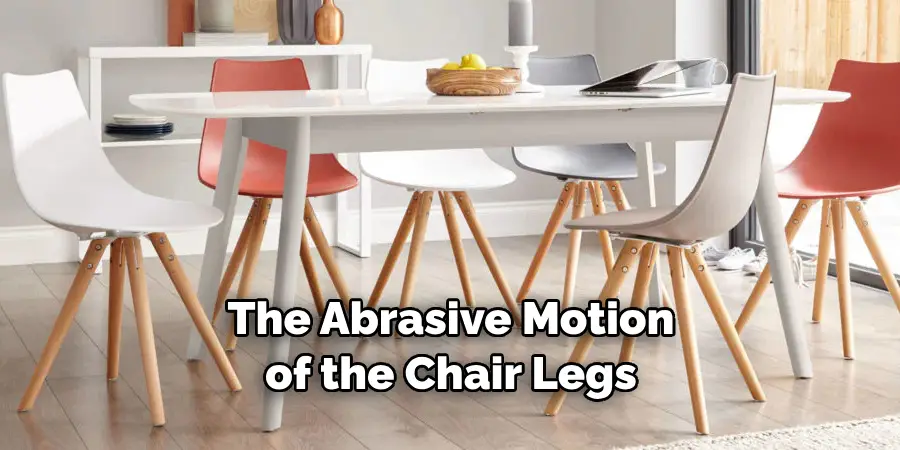
Additionally, dirt and debris that builds up under the chair legs can cause further damage. This dirt gets stuck in the grain of the wood, resulting in a dull and scratched appearance. Furthermore, it can cause the finish to wear off faster than normal.
The weight of the dining room chairs also plays a role in damaging wood floors. Heavy chairs can dent or indent wood floors if left in one spot too long. In general, it is best to avoid moving heavy furniture over hardwood flooring as much as possible.
10 Methods How to Protect Wood Floors from Dining Room Chairs
1. Preventing Scratches and Scuffs:
Wood floors are vulnerable to scratches and scuffs caused by the constant movement of chairs. Even small particles of dirt or debris trapped under chair legs can act like abrasive sandpaper, gradually wearing down the protective finish and exposing the delicate wood surface. By using protective measures, such as chair pads, leg protectors, or area rugs, you can create a barrier that reduces the risk of scratches and scuffs.
2. Preserving the Floor’s Finish:
Wood floors are often coated with a protective finish that enhances their beauty and provides resistance against spills and stains. However, dragging chairs across the floor or repeated impact can chip or wear away the finish, leaving the wood exposed and vulnerable to damage. Protecting the floor from dining room chairs helps maintain the integrity of the finish, prolonging its lifespan and reducing the need for refinishing.
3. Minimizing Noise:
Chairs scraping or dragging across a wood floor can produce irritating and disruptive noise, particularly in dining areas. This can be a nuisance for both residents and guests, impacting the overall dining experience. Implementing protective measures like chair glides or felt pads helps reduce friction and noise, creating a quieter and more enjoyable dining environment.
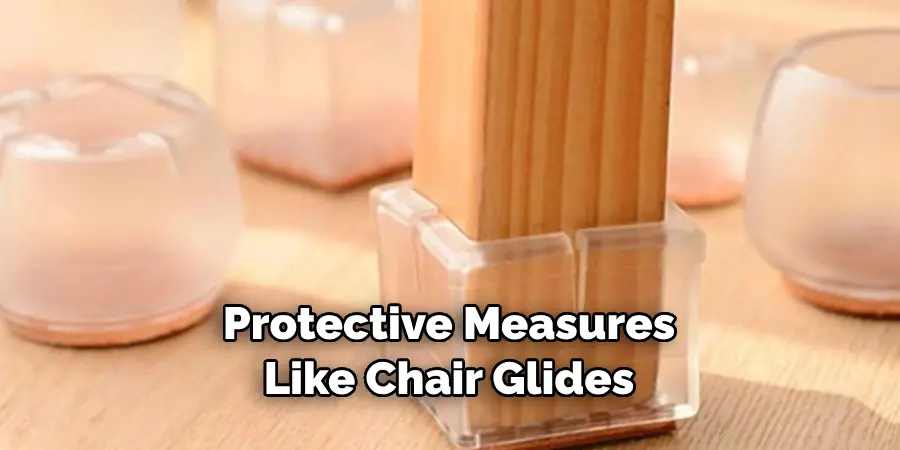
4. Enhancing Safety:
Loose or wobbly dining room chairs can pose a safety hazard, especially on smooth wood floors. Unstable chairs increase the risk of falls or accidents, potentially causing injuries. By using chair pads, glides, or other protective accessories, you can stabilize the chairs and improve safety, ensuring that they remain steady and secure on the floor.
5. Preserving Aesthetic Appeal:
Wood floors are often a focal point in dining rooms, adding warmth and sophistication to the space. Damaged floors can detract from the overall aesthetic appeal of the room, making it look worn or neglected. Protecting wood floors from dining room chairs helps maintain their pristine appearance, ensuring that they continue to be a visual highlight and complement the surrounding decor.
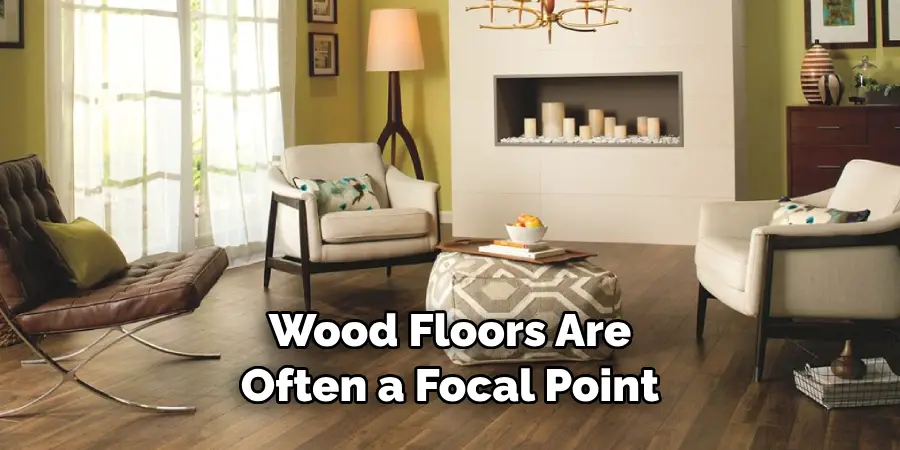
6. Maintaining Property Value:
Well-maintained wood floors can significantly enhance the value of a property. On the other hand, damaged or worn-out floors can be a deterrent to potential buyers and may decrease the overall value of the home. By taking steps to protect wood floors from dining room chairs, you not only safeguard your investment but also preserve the property’s marketability and appeal.
7. Ease of Maintenance:
Protected wood floors are easier to clean and maintain. When chairs are moved without proper precautions, they can leave behind marks or scuffs that require extensive cleaning or even professional intervention. By implementing protective measures, you can minimize the need for frequent and laborious floor maintenance, saving you time and effort.
8. Long-Term Cost Savings:
Repairing or refinishing damaged wood floors can be costly. By proactively protecting the floors from dining room chairs, you can prevent the need for such repairs or restoration projects. The investment in protective measures like chair pads or floor protectors is relatively small compared to the potential expenses associated with floor repairs or refinishing.
9. Environmental Considerations:
Opting for protective measures to safeguard wood floors contributes to sustainability and environmental conservation. Preserving the longevity of wood floors reduces the need for replacement, which in turn reduces the demand for new materials and the energy consumption associated with manufacturing and installation.

10. Setting a Positive Example:
Taking the initiative to protect wood floors from dining room chairs sets a positive example for others in the household or guests. It promotes responsible behavior and instills an understanding of the importance of maintaining and caring for the home’s surfaces and assets. By demonstrating the significance of floor protection, you create an environment where everyone is conscious of their actions and strives to preserve the integrity of the wood floors.
Conclusion
Wood floors are a beautiful addition to any home, but can be easily damaged if the proper steps to protect them aren’t taken. Thankfully, preventing damage from dining room chairs can be easy with the right supplies and precautions. Invest in chair pads of materials that won’t scuff or scratch the wood. Add felt tips to the legs of your chairs to prevent scraping. Vacuum or sweep regularly to make sure no small bits of debris are left behind on the floor.
Lastly, don’t forget to move furniture every now and then to avoid wearing down any particular spot of the floor too much. With these simple steps, you can ensure your wood floors stay looking beautiful for years and years to come! Thanks for reading our blog post on how to protect wood floors from dining room chairs! We hope you found it helpful and informative.
About
Angela is the chief editor of Indoorense. She began her career as an interior designer before applying her strategic and creative passion to lifestyle and home.
She has close to 15 years of experience in creative writing and online content strategy for housekeeping and cleaning,home decorations as well as other efforts.
She loves her job and has the privilege of working with an extraordinary team. She lives with her husband, two sons, and daughter in Petersburg. When she’s not busy working she spent time with her family.

